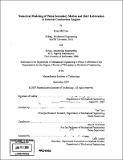| dc.contributor.advisor | Tian Tian and John B. Heywood. | en_US |
| dc.contributor.author | McClure, Fiona | en_US |
| dc.contributor.other | Massachusetts Institute of Technology. Dept. of Mechanical Engineering. | en_US |
| dc.date.accessioned | 2008-11-10T19:58:45Z | |
| dc.date.available | 2008-11-10T19:58:45Z | |
| dc.date.copyright | 2007 | en_US |
| dc.date.issued | 2007 | en_US |
| dc.identifier.uri | http://hdl.handle.net/1721.1/42289 | |
| dc.description | Thesis (Ph. D.)--Massachusetts Institute of Technology, Dept. of Mechanical Engineering, 2007. | en_US |
| dc.description | Includes bibliographical references (p. 239-241). | en_US |
| dc.description.abstract | Internal combustion engines dominate transportation of people and goods, contributing significantly to air pollution, and requiring large amounts of fossil fuels. With increasing public concern about the environment and the reliability of oil supplies, automotive companies are pushed to improve engine design in order to reduce engine emissions and fuel consumption. This project aims to develop a numerical model of piston dynamics and lubrication in internal combustion engines, enabling prediction of friction generation at the piston -cylinder bore interface, and oil transport in the power cylinder system. It is currently estimated that the piston - cylinder bore friction accounts for up to 25% of the power loss in a typical engine, while oil transported to the combustion chamber by the piston and ring-pack contributes significantly to engine emissions. A dry piston model was first developed to allow fast calculation of approximate piston dynamics. An elastohydrodynamic lubrication model was then developed to allow direct numerical simulation of the effect of piston tooling marks, and comparison with results obtained using an Average Reynolds equation with flow factors. The lubrication model was incorporated into the piston dynamics model, enabling more accurate evaluation of friction and oil transport. Comparison between the dry and lubricated model results demonstrate the effect of oil film thickness on piston lateral motion, tilt, friction generation and oil transport. | en_US |
| dc.description.statementofresponsibility | by Fiona McClure. | en_US |
| dc.format.extent | 241 p. | en_US |
| dc.language.iso | eng | en_US |
| dc.publisher | Massachusetts Institute of Technology | en_US |
| dc.rights | M.I.T. theses are protected by
copyright. They may be viewed from this source for any purpose, but
reproduction or distribution in any format is prohibited without written
permission. See provided URL for inquiries about permission. | en_US |
| dc.rights.uri | http://dspace.mit.edu/handle/1721.1/7582 | en_US |
| dc.subject | Mechanical Engineering. | en_US |
| dc.title | Numerical modeling of piston secondary motion and skirt lubrication in internal combustion engines | en_US |
| dc.type | Thesis | en_US |
| dc.description.degree | Ph.D. | en_US |
| dc.contributor.department | Massachusetts Institute of Technology. Department of Mechanical Engineering | en_US |
| dc.identifier.oclc | 232158310 | en_US |
